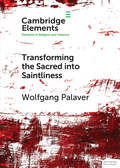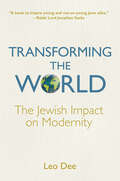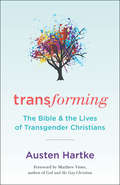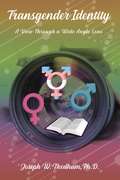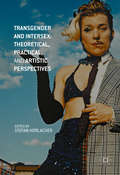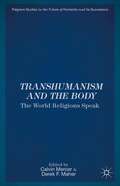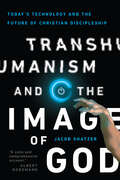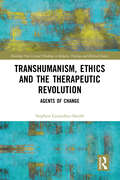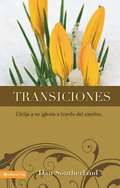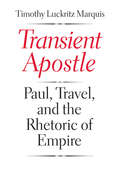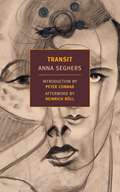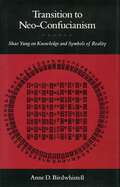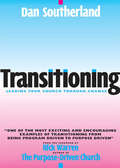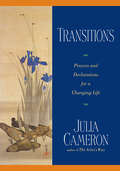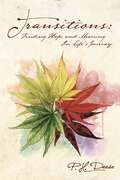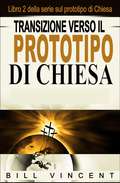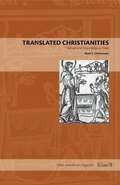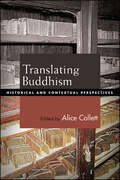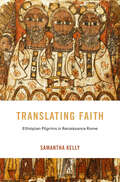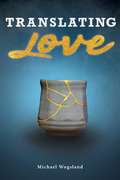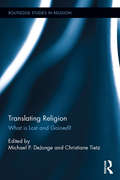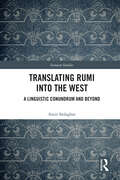- Table View
- List View
Transforming the Sacred into Saintliness: Reflecting on Violence and Religion with René Girard (Elements in Religion and Violence)
by Wolfgang PalaverStudies into religion and violence often put religion first. René Girard started with violence in his book Violence and the Sacred and used the Durkheimian term 'sacred' as its correlate in his study of early religions. During the unfolding of his theory, he more and more distinguished the sacred from saintliness to address the break that the biblical revelation represented in comparison to early religions. This distinction between the sacred and saintliness resembles Henri Bergson's complementing Emile Durkheim's identification of the sacred and society with a dynamic religion that relies on individual mystics. Girard's distinction also relates to the insights of thinkers like Jacques Maritain, Simone Weil, and Emmanuel Levinas. This element explores some of Girard's main features of saintliness. Girard pleaded for the transformation of the sacred into holy, not their separation.
Transforming the World: The Jewish Impact on Modernity
by Leo DeeRabbi Leo Dee answers the fundamental question: why bother being Jewish in a modern world? Using history and logic, Rabbi Dee explains how Judaism enhances daily life to make it more meaningful. Transforming the World: The Jewish Impact on Modernity focuses on the tolerance and equality of all mankind that is fundamental in Judaism. With a combination of commandments, traditions, and history, Rabbi Dee shows how Jewish culture transforms your life and the wider world for the better.
Transforming: The Bible And The Lives Of Transgender Christians
by Austen HartkeIn 2014, Time magazine announced that America had reached “the transgender tipping point,” suggesting that transgender issues would become the next civil rights frontier. Years later, many people—even many LGBTQ allies—still lack understanding of gender identity and the transgender experience. Into this void, Austen Hartke offers a biblically based, educational, and affirming resource to shed light and wisdom on this modern gender landscape. Transforming: The Bible and the Lives of Transgender Christians provides access into an underrepresented and misunderstood community and will change the way readers think about transgender people, faith, and the future of Christianity. By introducing transgender issues and language and providing stories of both biblical characters and real-life narratives from transgender Christians living today, Hartke helps readers visualize a more inclusive Christianity, equipping them with the confidence and tools to change both the church and the world.
Transgender Identity: A View through a Wide Angle Lens
by Joseph W. NeedhamTransgender Identity is a reality in 21st century American and world cultures. Dr. Joseph Needham, a long-time pastor, professor, and Bible teacher, examines this fact in light of Scripture, science, psychology, history, and philosophy. His insights include suggestions and strategies for those dealing with gender dysphoria.
Transgender Journeys
by Virginia Ramey Mollenkott Vanessa SheridanTransgendered people and religious life.
Transgender and Intersex: Theoretical, Practical, and Artistic Perspectives
by Stefan HorlacherThis book takes both transgender and intersex positions into account and asks about commonalities and strategic alliances in terms of knowledge, theory, philosophy, art, and life experience. It strikes a balance between works on literature, film, photography, sports, law, and general theory, bringing together humanistic and social science approaches. Horlacher adopts a non-hierarchical perspective and asks how transgender and intersex issues are conceptualized from a variety of different viewpoints and to what extent artistic and creative discourses offer their own uniquely relevant forms of knowledge and expression.
Transgression (City of God #1)
by Randall IngermansonWhile playing a virtual reality game, Rivka Meyers, an American Messianic Jew visiting Israel for an archaeological dig, becomes trapped in ancient Salem, and involved in a plot to destroy the spread of Christianity.
Transhumanism and the Body
by Calvin Mercer Derek F. MaherAs a result of the fast-developing array of human enhancement therapies and technologies - commonly subsumed under the term "transhumanism" - the "flesh and blood" body of the human species may be significantly modified in the immediate future, or eventually eliminated, if some have their way. The proposed collection of original articles, a sequel of sorts to the 2009 Religion and the Implications of Radical Life Extension (Palgrave Macmillan), is the first sustained reflection, by scholars with expertise in the faith traditions, on how the transhumanist agenda might impact the body.
Transhumanism and the Image of God: Today's Technology and the Future of Christian Discipleship
by Jacob ShatzerWe're constantly invited to think about the future of technology as a progressive improvement of tools: our gadgets will continue to evolve, but we humans will stay basically the same. In the future, perhaps even alien species and intelligent robots will coexist alongside humans, who will grapple with challenges and emerge as the heroes. But the truth is that radical technological change has the power to radically shape humans as well. We must be well informed and thoughtful about the steps we're already taking toward a transhuman or even posthuman future. Can we find firm footing on a slippery slope? Biblical ethicist Jacob Shatzer guides us into careful consideration of the future of Christian discipleship in a disruptive technological environment. In Transhumanism and the Image of God, Shatzer explains the development and influence of the transhumanist movement, which promotes a "next stage" in human evolution. Exploring topics such as artificial intelligence, robotics, medical technology, and communications tools, he examines how everyday technological changes have already altered and continue to change the way we think, relate, and understand reality. By unpacking the doctrine of the incarnation and its implications for human identity, he helps us better understand the proper place of technology in the life of the disciple and avoid false promises of a posthumanist vision. We cannot think about technology use today without considering who we will become tomorrow.
Transhumanism, Ethics and the Therapeutic Revolution: Agents of Change (Routledge New Critical Thinking in Religion, Theology and Biblical Studies)
by Stephen Goundrey-SmithThis book explores the impact of developments in pharmaceutical medicine in the twentieth century on a Christian ethical evaluation of transhumanism and future "hi-tech" medical enhancement technologies. It suggests that the Christian ethical assessment of proposed future radical transhumanist biomedical technologies should be conducted in the light of responses to past medical advances. Two specific case studies are featured, focusing on the oral contraceptive pill and on Prozac and selective serotonin reuptake inhibitor (SSRI) antidepressants. Whilst future biomedical technologies may have therapeutic benefits for the relief of disease and contribute to improving human health and welfare, the book considers the implications for society and their acceptability as therapies from a Christian perspective. Stressing the inadequacy of natural law alone, the author proposes an ethical framework for assessing novel biomedical technologies according to the effects on personal autonomy, embodiment and bodily life, and on the imago Dei.
Transiciones: Dirija a su iglesia a través del cambio
by Dan Southerland"Dan Southerland guió a su congregación hacia la renovación, la salud y el crecimiento mediante un brillante proceso de transición paso a paso…Si usted es un pastor o líder clave de una iglesia establecida, este manual lo ayudará a implementar los principios de una iglesia con propósito…Este libro es para estudiarlo, no para leerlo solamente." Rick Warren "Tuve el privilegio de ser uno de los pastores de una iglesia que navegó con éxito los mares de la transición. En los últimos nueve años, tuvimos nueve transiciones grandes, la asistencia se multiplicó siete veces y plantamos dieciséis misiones. Estoy convencido de que Dios nos permitió aprender sobre la transición para poder contarle a otros líderes de iglesias lo aprendido." Dan Southerland
Transient Apostle
by Timothy Luckritz MarquisIn a significant reevaluation of Paulâ TMs place in the early Christian story, Timothy Luckritz Marquis explores the theme of travel in the apostleâ TMs correspondence. He casts Paulâ TMs rhetorical strategies against the background of Augustusâ TMs age, when Romeâ TMs wealth depended on conquests abroad, the international commerce they facilitated, and the incursion of foreign customs and peoples they brought about. In so doing, Luckritz Marquis provides an explanation for how Paul created, maintained, and expanded his local communities in the larger, international Jesus movement and shows how Paul was a product of the material forces of his day.â œThis is the single most sophisticated book on Paul to be written within the paradigms of contemporary critical thought. By integrating its extensive, erudite, and compelling citations of the Greco-Roman world in which Paul was writing with post-colonial and post-Marxist thinking, it makes real progress in understanding Paulâ TMs letters.â ?â "Daniel Boyarin
Transit
by Peter Conrad Anna Seghers Heinrich Boll Margot Bettauer DemboAnna Seghers's Transit is an existential, political, literary thriller that explores the agonies of boredom, the vitality of storytelling, and the plight of the exile with extraordinary compassion and insight. Having escaped from a Nazi concentration camp in Germany in 1937, and later a camp in Rouen, the nameless twenty-seven-year-old German narrator of Seghers's multilayered masterpiece ends up in the dusty seaport of Marseille. Along the way he is asked to deliver a letter to a man named Weidel in Paris and discovers Weidel has committed suicide, leaving behind a suitcase containing letters and the manuscript of a novel. As he makes his way to Marseille to find Weidel's widow, the narrator assumes the identity of a refugee named Seidler, though the authorities think he is really Weidel. There in the giant waiting room of Marseille, the narrator converses with the refugees, listening to their stories over pizza and wine, while also gradually piecing together the story of Weidel, whose manuscript has shattered the narrator's "deathly boredom," bringing him to a deeper awareness of the transitory world the refugees inhabit as they wait and wait for that most precious of possessions: transit papers.
Transition to Neo-Confucianism
by Anne D. BirdwhistellThe Sung Neo-Confucian synthesis is one of the two great formative periods in the history of Confucianism. Shao Yung (1011-77) was a key contributor to this synthesis, and this study attempts to make understandable the complex and highly theoretical thought of a philosopher who has been, for the most part, misunderstood for a thousand years. It is the first full-length study in any language of Shao Yung's philosophy. Using an explicit metaphilosophical approach, the author examines the implicit and assumed aspects of Shao Yung's thought and shows how it makes sense to view his philosophy as an explanatory theory. Shao Yung explained all kinds of change and activity in the universe with six fundamental concepts that he applied to three realms of reality: subsensorial "matter," the phenomenal world of human experience, and the theoretical realm of symbols. The author also analyzes the place of the sage in Shao's philosophy. Not only would the sage restore political and moral unity in society, but through his special kind of knowing he also would restore cosmological unity. Shao's recognition that the perceiver had a critical role in making and shaping reality led to his ideal of the sage as the perfect knower. Utilizing Shao's own device of a moving observational viewpoint, the study concludes with an examination of the divergent interpretations of Shao's philosophy from the eleventh to the twentieth century. Because Shao took very seriously numerological aspects of Chinese thought that are often greatly misunderstood in the West (e. g. , the I Ching), the study is also a very good introduction to the epistemological implications of an important strand of all traditional Chinese philosophical thought.
Transitioning
by Dan SoutherlandA biblical look at how to steer a congregation in a new and exciting direction aligned with God's unique purpose for them. Transitioning is written to help church leaders and their congregations successfully navigate change and discover that the rewards far exceed the risk. Drawing principles from the book of Nehemiah, Southerland maps out an eight-step strategy for moving from being a traditional, ministry-driven church to a purpose-driven church. Transitioning illustrates practical, field-tested concepts with examples from the Bible and Southerland's own experience. A detailed workbook section with fill-in-the-blanks, scripture passages, and action steps helps pastors and their leadership teams convert knowledge into reality.
Transitions
by Julia CameronIn this gift-sized book, Julia Cameron shares beautiful prayers of empowerment followed by potent declarations and reflections on the nature of change and coping. They extend beyond affirmations to facilitate a powerful awakening of the potential of the human soul and to revitalize our abilities to transform our lives in the face of whatever the universe may put in our life's path. Transitions will help guide the soul and draw readers toward the source of their inner strength. Whether read in one sitting, or used over time, this is a book no thoughtful being will want to be without.
Transitions: Finding Hope and Meaning In Life’s Journey
by P. H. DeeseThe “Transitions” Bible study is designed to realign your core beliefs with God’s actual truth, as revealed in His word. So often, we all try to understand God’s promises in a familiar but broken way as we face seasonal changes and challenges throughout our lives. This can lead to discouragement, frustration, and fear. I know because it is out of that fire in my life that this study was born. It is my prayer that this study will create a shift in your thinking so that you will experience God’s truth in a new and fresh way. We all face seasonal transitions throughout our lives. How we handle those changes is the refining fire that God uses to craft us into the person He intends us to be. Because there are so many pitfalls throughout this process, it is easy to lose sight of what God is doing, falter in our trust, and end up in a ditch. There is a strong desire to “lean on our own understanding” when, in truth, our understanding is limited to what we have learned and experienced. In this study, you will identify your core beliefs and then compare them to what God tells you in His word. It is my hope and prayer that you will come to understand God’s truth and promises in a fresh, new and encouraging way.
Transizione verso il Prototipo di Chiesa (Prototipo di Chiesa #2)
by Bill Vincent Giuseppe FontanellaLibro 2 della serie sul prototipo di Chiesa La Chiesa si trova in un periodo di profondo cambiamento Bill Vincent è uno scrittore profetico unto che rilascia una potente nuova rivelazione in tutto ciò che fa. Bill pubblicò prima il suo potente libro BUILDING A PROTOTYPE CHURCH e ora Volume 2 TRANSITIONING ALLA CHIESA DEL PROTOTIPO. Sarai in grado di vedere nel cuore di Dio un nuovo tipo di Chiesa che viene fuori. Questo libro aiuterà chiunque desideri essere qualcosa di più di una Chiesa di tutti i giorni. Dio convertirà veramente la tua Chiesa mentre ottieni tutte le rivelazioni approfondite in questo libro rivoluzionario. Che lo Spirito di Dio ti aiuti mentre inizi a PASSARE ALLA CHIESA DEL PROTOTIPO.
Translated Christianities: Nahuatl and Maya Religious Texts (Latin American Originals #8)
by Mark Z. ChristensenBeginning in the sixteenth century, ecclesiastics and others created religious texts written in the native languages of the Nahua and Yucatec Maya. These texts played an important role in the evangelization of central Mexico and Yucatan. Translated Christianities is the first book to provide readers with English translations of a variety of Nahuatl and Maya religious texts. It pulls Nahuatl and Maya sermons, catechisms, and confessional manuals out of relative obscurity and presents them to the reader in a way that illustrates similarities, differences, and trends in religious text production throughout the colonial period. The texts included in this work are diverse. Their authors range from Spanish ecclesiastics to native assistants, from Catholics to Methodists, and from sixteenth-century Nahuas to nineteenth-century Maya. Although translated from its native language into English, each text illustrates the impact of European and native cultures on its content. Medieval tales popular in Europe are transformed to accommodate a New World native audience, biblical figures assume native identities, and texts admonishing Christian behavior are tailored to meet the demands of a colonial native population. Moreover, the book provides the first translation and analysis of a Methodist catechism written in Yucatec Maya to convert the Maya of Belize and Yucatan. Ultimately, readers are offered an uncommon opportunity to read for themselves the translated Christianities that Nahuatl and Maya texts contained.
Translated Christianities: Nahuatl and Maya Religious Texts (Latin American Originals)
by Mark Z. ChristensenBeginning in the sixteenth century, ecclesiastics and others created religious texts written in the native languages of the Nahua and Yucatec Maya. These texts played an important role in the evangelization of central Mexico and Yucatan. Translated Christianities is the first book to provide readers with English translations of a variety of Nahuatl and Maya religious texts. It pulls Nahuatl and Maya sermons, catechisms, and confessional manuals out of relative obscurity and presents them to the reader in a way that illustrates similarities, differences, and trends in religious text production throughout the colonial period. The texts included in this work are diverse. Their authors range from Spanish ecclesiastics to native assistants, from Catholics to Methodists, and from sixteenth-century Nahuas to nineteenth-century Maya. Although translated from its native language into English, each text illustrates the impact of European and native cultures on its content. Medieval tales popular in Europe are transformed to accommodate a New World native audience, biblical figures assume native identities, and texts admonishing Christian behavior are tailored to meet the demands of a colonial native population. Moreover, the book provides the first translation and analysis of a Methodist catechism written in Yucatec Maya to convert the Maya of Belize and Yucatan. Ultimately, readers are offered an uncommon opportunity to read for themselves the translated Christianities that Nahuatl and Maya texts contained.
Translating Buddhism: Historical and Contextual Perspectives
by Alice CollettAlthough many Buddhist studies scholars spend a great deal of their time involved in acts of translation, to date not much has been published that examines the key questions, problems, and difficulties faced by translators of South Asian Buddhist texts and epigraphs. Translating Buddhism seeks to address this omission. The essays collected here represent a burgeoning attempt to begin to shape the subfield of translation studies within Buddhist studies, whereby scholars actively challenge primary routine decisions and basic assumptions. Exploring questions including how interpretive translators can be and how cultural and social norms affect translations, the book draws on the broad experiences of its contributors—all of whom are translators themselves—who bring different themes to the table. Each chapter can be used either independently or as part of the whole to engender reflections on the process of translation.
Translating Faith: Ethiopian Pilgrims in Renaissance Rome (I Tatti Studies in Italian Renaissance History #32)
by Samantha KellyA revealing account of the lives and work of Ethiopian Orthodox pilgrims in sixteenth-century Rome, examining how this African diasporic community navigated the challenges of religious pluralism in the capital of Latin Christianity.Tucked behind the apse of Saint Peter’s Basilica in Rome is the ancient church of Santo Stefano. During the sixteenth century, Santo Stefano hosted an unusual community: a group of Ethiopian Orthodox pilgrims whose faith and culture were both like and unlike those of Latin Europe. The pilgrims of Santo Stefano were the only African community in premodern Europe to leave extensive documents in their own language (Gǝʿǝz). They also frequently collaborated with Latin Christians to disseminate their expert knowledge of Ethiopia and Ethiopian Christianity, negotiating the era’s heated debates over the boundaries of religious belonging.Translating Faith is the first book-length study of this community in nearly a century. Drawing on Gǝʿǝz and European-language sources, Samantha Kelly documents how pilgrims maintained Ethiopian Orthodox practices while adapting to a society increasingly committed to Catholic conformity. Focusing especially on the pilgrims’ scholarly collaborations, Kelly shows how they came to produce and share Ethiopian knowledge—as well as how Latin Christian assumptions and priorities transformed that knowledge in unexpected ways. The ambivalent legacies of these exchanges linger today in the European tradition of Ethiopian Studies, which Santo Stefano is credited with founding.Kelly’s account of the Santo Stefano pilgrim community is a rich tale about the possibilities and pitfalls of ecumenical dialogue, as well as a timely history in our own age marked by intensive and often violent negotiations of religious and racial difference.
Translating Love
by Michael WogslandWhat if love meant that Freedom was found in service, purpose was found in pain, strength was found in suffering, and life was found in death? Life would change! This is the story of a pastor and missionary named Mike, who thought he had all the answers and yet found himself empty, broken, depressed, and destroyed. He had dedicated his life to helping the hurting, lifting the poor, and bringing hope to the hopeless, yet here he was burned out and broken! He was finished. That was until he met a man, a man named Hal. Through translating his own life experiences Hal acquainted Mike with a love that he had never known before. He would show Mike that beauty could be found in ashes, value could be found in brokenness, and that purpose could be found in tragedy! Translating Love is about learning how to translate and understand the love of the Messiah in the good, bad, and ugly of all of our stories.
Translating Religion: What is Lost and Gained? (Routledge Studies in Religion)
by Michael DeJonge Christiane TietzTranslating Religion advances thinking about translation as a critical category in religious studies, combining theoretical reflection about processes of translation in religion with focused case studies that are international, interdisciplinary, and interreligious. By operating with broad conceptions of both religion and translation, this volume makes clear that processes of translation, broadly construed, are everywhere in both religious life and the study of religion; at the same time, the theory and practice of translation and the advancement of translation studies as a field has developed in the context of concerns about the possibility and propriety of translating religious texts. The nature of religions as living historical traditions depends on the translation of religion from the past into the present. Interreligious dialogue and the comparative study of religion require the translation of religion from one tradition to another. Understanding the historical diffusion of the world’s religions requires coming to terms with the success and failure of translating a religion from one cultural context into another. Contributors ask what it means to translate religion, both textually and conceptually, and how the translation of religious content might differ from the translation of other aspects of human culture. This volume proposes that questions on the nature of translation find particularly acute expression in the domains of religion, and argues that theoretical approaches from translation studies can be fruitfully brought to bear on contemporary religious studies.
Translating Rumi into the West: A Linguistic Conundrum and Beyond (Iranian Studies)
by Amir SedaghatFocusing on Rumi, the best-selling Persian mystical poet of the 13th century, this book investigates the reception of his work and thought in North America and Europe – and the phenomenon of ‘Rumimania’ – to elucidate the complexities of intercultural communication between the West and the Iranian and Islamic worlds. Presenting tens of examples from the original and translated texts, the book is a critical analysis of various dimensions of this reception, outlining the difficulties of translating the text but also exploring how translators of various times and languages have performed, and explaining why the quality of reception varies. Topics analysed include the linguistic and pragmatic issues of translation, comparative stylistics and poetics, and non-textual factors like the translator’s beliefs and the political and ideological aspects of translation. Using a broad theoretical framework, the author highlights the difficulties of intercultural communication from linguistic, semiotic, stylistic, poetic, ethical, and sociocultural perspectives. Ultimately, the author shares his reflections on the semiotic specificities of Rumi’s mystical discourse and the ethics of translation generally. The book will be valuable to scholars and students of Islamic philosophy, Iranian studies, and translation studies, but will appeal to anyone interested in the cultural dichotomies of the West and Islam.
